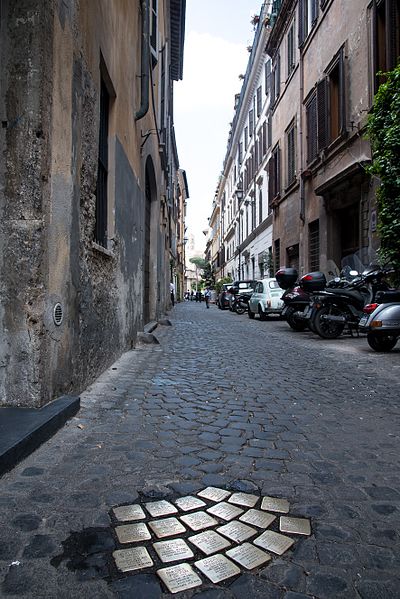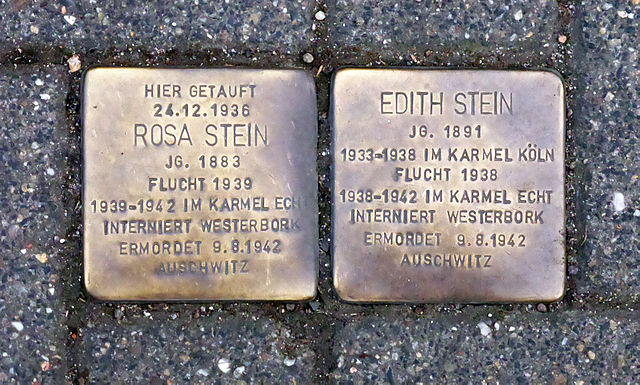
via Wikimedia Commons
Stumbling Stone
Not really a stone. A little bronze plate the size of a cobblestone,
flush with the pavement. No one could trip over it
except the way the eye catches on something bright
and the mind cannot let it go, that idea that stays with you
all day long until you go back to see more clearly
the thing you thought you saw, read the words again
and again and again: name, date of birth, lived here in this place
arrested taken abducted kidnapped removed from this life in this place
tortured imprisoned killed never to return never again to see
home neighbors this familiar threshold where so often
the unseeing foot tripped over nothing as she was woolgathering
her way along home with a book in her hand or a poem in her head
that never did get written down, a song that never resolved itself
into something she could sing. And after that day
of screaming and crying she never saw him again
but here in bronze they stand side by side
reunited not in person but in memory.
Linger here, remember this name, this person
in this place. Not a number but one, unrepeatable
name murmured by her mother, called by her brother
whispered by her husband, and never ever forgotten
by the Namer of all who holds all the named and unnamed
in his hands and remembers every one of those hairs.
This week I stumbled upon this story about a German artist who has been installing memorials that he calls “stolpersteine” or stumbling stones. I was intrigued and spent a lot of time reading about him and his work.
Here’s the initial piece:
These “Stolpersteine,” German for “stumbling stones,” are a very different kind of Holocaust memorial. They personalize the tragedy, marking the specific place where the victim lived or worked before being forced from their home and sent to extermination camps.
There are more than 200 of the mini memorials in Rome, called pietri d’inciampo here, Italian for “stumbling stone.” You’ll find many of the cobbles outside doorways in the old Jewish Quarter, sometimes grouped together with one stone for each member of a family. They are tragic reminders of the former residents who were deported from Italy—Jews as well as Romani people and many other innocents deemed enemies of the Nazi regime.
The Roman cobblestones are part of a larger project started by German artist Gunter Demnig. There are more than 30,000 of the tiny brass squares around Europe, in cities throughout Germany as well as several other countries. The idea is that stumbling upon the shiny cobbles forces you to look down in respect, and devote a moment to pause and reflect on those dark years.
From Gunter Demnig’s Stolperstein website:
“In direct opposition to the Nazis‘ mass extermination policies, Gunter Demnig insists that each Stolperstein be made by hand. He no longer has time to make them himself but the sculptor Michael Friedrichs-Friedlaender makes each stone by hand in his Berlin studio.”
“No installation is a routine event. Each fate was different and each STOLPERSTEIN is supposed to move passers-by. There should be no mass installations – in direct opposition to the mass extermination.”
“STOLPERSTEINE are not only placed for people who died, but also for “survivors”. For example, in front of a house in Amsterdam, a STOLPERSTEIN might be placed for a woman who survived Auschwitz alongside two STOLPERSTEINE for her parents who did not. This “reunites” families. STOLPERSTEINE can also be placed for people who were able to escape to Palestine or South America or survivors of concentration camps. The project also commemorates those forced by the circumstances to commit suicide.”
“STOLPERSTEINE have different functions. They bring names and fates of individuals back to where they lived and can thus help relatives to remember and to cope with their trauma. They can also help local communities to explore the past and anchor commemoration locally. They promote public debate and involve young generations in commemoration by getting them to conduct research and explore the past. Ideally, they should help to counter similar developments in society today, making people aware of human rights violations and reminding them of how important an open, broad-minded society is.”
I also found images of the stolpersteine for St Edith Stein and her sister Rosa, presumably placed near the Carmel in Köln (Cologne) where they lived until they fled to the Carmel in Echt in the Netherlands, where they were arrested and then sent to Auschwitz where they were killed.

via Wikimedia Commons





